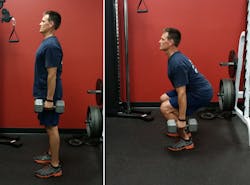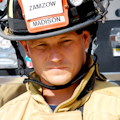Physical training and being in shape is vitality important, just as important as sharpening your mental skills. Around most firehouse workout rooms, there seems to be a constant focus on the newest, flashiest and trendiest workout regimen or exercise. But, in pursuing the new, the cutting-edge and the fresh, we can sometimes overlook the basics. With that in mind, I would like to share with you five underrated firefighter exercises that firefighters have a tendency to skip or forget to integrate into their workouts.
When it comes to these underutilized exercises, a lot of it comes back to the fact that they don't focus on muscles or movements that are considered “sexy.” Granted, these exercises will work every muscle in your body, but they don't focus on the biceps, abs or chest specifically. One thing is certain, though: These underrated exercises work the muscles that are essential for the demands of the fireground.
1. Crawling
Crawling—the movement you used to do as a child—could be the one thing that can improve your strength, mobility and performance on the fireground. Most of us don’t think of crawling as an exercise (or we just don’t think about it at all), but consider how integral a movement this is on the fireground, as we navigate through a building to search for a trapped occupant.
Incorporate crawling after your next strength training or cardio session. Think of crawling like it's a traveling core exercise. You have to maintain the same rigid, neutral core you would while in a plank position, but with the crawl, you’re moving forward, backward and side-to-side. All you need to do to feel the burn in your shoulders, quads and core is get down on your hands and feet and move around for a couple sets of 20 to 30 seconds.
How to do it: To use nearly every muscle in your body, try to crawl (on your hands and toes) in different directions: forward, backward and sideways. Additionally, you can work through these crawling movements slowly and with a weighted vest for strength, stamina and flexibility, or you can do them explosively for speed, power and agility. Try to crawl for three sets of 20 to 30 seconds at the end of your workout.
2. Farmer’s Carry
One of the basic principles of the fireground is to make sure you always have a tool in your hand. Some of the tools we carry are lighter, and some can weigh almost 100 pounds. Regardless of weight, carrying is a movement that requires good grip strength, core stability and balance—and it should be an exercise in every firefighter’s workout.
While simple to perform, the Farmer’s (or Suitcase) Carry exercises are among the most challenging exercises you’ll ever try. These carry exercises are like a moving plank, where you must engage your core to stabilize your trunk and hips while you walk with weight. Farmer’s Carries (and variations of it) are all great ways to improve conditioning, grip strength, work capacity and mental fortitude.
How to do it: Grab some weights, sandbags, kettle bells or something heavy. Then stand up straight and walk for a predetermined distance or time. There are variations related to how you carry the weight. I suggest to start with the Suitcase Carry, meaning the weight is at your sides, and then progress to shoulder carry, where the weights are at your shoulders. Use caution when picking up and putting down the weights. One of the biggest mistakes I see is people using poor lifting technique. Finally, make sure to keep your head and shoulders back at all times. Dropping your head or rounding your shoulders will increase the risk of injury and eventually limit your performance. Walk using a normal stride at first then shorten your steps as you become tired to help maintain proper technique. Try the Farmer’s Carry for 2 or 3 sets of 30 to 90 seconds at the end of your next workout.
3. Deadlift
The deadlift is probably the most popular of the underrated exercises, so why did it make the list? The deadlift can be an intimidating exercise, so many firefighters have a tendency to skip it or substitute the leg press for it. If you break down the mechanics and motion of the deadlift, it’s easy to recognize that as firefighters we perform the deadlift many times a shift and don't realize it: grabbing a cot, lifting hose, carrying saws and tools, etc. Deadlifts are a part of our job. Getting better at the deadlift and incorporating it into your exercise program only makes sense.
How to do it: Nothing is more natural to the human body than the task of lifting something from the ground. The principal idea of the deadlift is very simple—pick up a barbell or dumbbells off the ground and set it or them back down.
4. Drags
Pulling or dragging things around is difficult, which is why most of us avoid doing it. Like crawling, this movement isn’t usually thought of as an exercise. However, pulls or drags are things we do on the fireground or on a rescue scene, so it only makes sense that we integrate this movement into our workout routine.
The benefits of dragging as an exercise are numerous. Dragging is a lower-impact exercise, so for people who have bad knees or other ailments, dragging is perfect. Dragging works the muscles of the core and strengthens your legs, glutes and ankles, which improves your balance. Depending on the size of the object and distance, dragging can work your cardiovascular recovery and challenge your overall conditioning.
How to do it: How and what to drag depends on the room and objects you have available. One of the easiest (and most common) items to drag is a large tire. You can also change the direction and angle of your drags—forward, backward and sideways—which challenges your muscles in different planes of motion (like that on the fireground). I recommend dragging a mid-size tractor tire (100 to 250 pounds) over a short distance. You can easily tie some webbing around the tire to use as a handle/harness, or just use the edge of a sledge. The biggest point to remember when performing a drag is to maintain good posture and focus on engaging the muscle of the core.
5. Glute bridges
The bridge is a common exercise in the rehabilitation field but not a mainstream exercise. Firefighters use the glutes for almost every fireground operation, which makes them one of the most important muscles in the body to train. The glutes have also been described as the brain of the lower body because they control everything that happens in your legs. What’s so great about the glute bridge is that it’s simple and versatile, and everyone who sits on their butt for hours or wants to be stronger and more powerful stands to benefit from it.
How to do it: The classic glute bridge is great to perform anytime, especially toward the start of a workout. Here are the basics of how to do a glute bridge. Begin by lying flat on the floor in supine position with knees bent, feet flat, toes pointing straight ahead and arms by sides. Activate your core by drawing the navel toward the spine and squeezing the glutes. With core engaged and glutes squeezed, push through your heels and lift your hips off the ground to form a straight line between your knees and shoulders. Hold and slowly return back to the floor, touching the floor momentarily then repeat. Try to perform 1 or 2 sets of 10 to 15 reps.
Wrap-up
Here's hoping these five exercises will help you break out of an exercise rut or plateau. Incorporating them into your workout program will help you become a better fire rescue athlete.
About the Author
Aaron Zamzow
Aaron Zamzow is a firefighter/training officer for Madison, WI, Fire Department. He holds a bachelor’s degree in health/wellness and has 20 years of experience as a fitness trainer. He created Fire Rescue Fitness and authors programs that are aimed at getting fire rescue athletes fit for duty.

